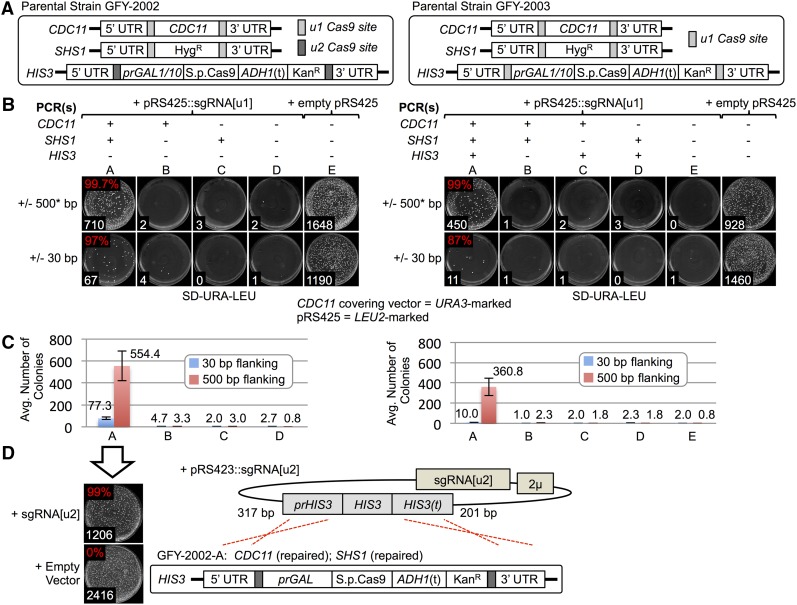Figure 2.
Multiplex Cas9-mediated scarless gene replacement (including an essential gene) and optional concurrent elimination of Cas9. (A) Otherwise isogenic yeast strains containing six programmed Cas9 target sites. In strain GFY-2002, the CDC11 and shs1∆::HygR loci are flanked by u1, whereas the Cas9 expression cassette at the HIS3 locus is flanked by u2. In strain GFY-2003, all three loci are flanked by u1. Both strains also carried a URA3-marked CEN plasmid harboring WT CDC11. (B) Cas9 expression was induced in strains GFY-2002 (left) or GFY-2003 (right), and then the cells were transformed with an empty LEU2-marked vector (pRS425) or with the same plasmid expressing sgRNA[u1] in the absence or presence of various combinations of PCR fragments that span each of the genomic loci of interest, as indicated. The PCR fragments contained either 500 bp (upper plates) or just 30 bp (lower plates) of homology to the genomic sequence flanking each locus. Asterisk, for the CDC11 PCR fragment, the flanking homology was 330 bp. After recovery in rich medium containing galactose (to support continued Cas9 expression), the cells were plated on SD-Ura-Leu medium. The plates were imaged and the number of colonies recovered were counted after incubation at 30° for 3 d. Each independent trial was performed in triplicate. Representative plates are shown; white numbers, total colony count. The empty vector control confirmed that these conditions allowed for efficient transformation and selection for the LEU2- and URA3-marked plasmids. Individual colonies from Condition A, where all of the PCR fragments necessary to heal the Cas9-sgRNA[u1]-generated DSBs were provided, were tested for growth on various diagnostic media to ascertain whether successful gene replacement occurred (see Table S3). Red values, percentage of colonies scored that exhibited successful gene replacement at all loci tested. (C) The average colony count over all experimental trials for each condition (A–D), as indicated. Error bars, SEM. (D) An isolate of GFY-2002 from Condition A (B and C) in which both the u1-flanked CDC11 locus and u1-flanked shs1∆::HygR allele were successfully replaced with WT CDC11 (see Figure 3) and WT SHS1, respectively, was grown in galactose to induce Cas9 expression, and then transformed with either empty vector (pRS423) or the same plasmid expressing sgRNA[u2], plated on SD-Ura-His medium, and grown at 30° for 3 d. The selectable marker in the sgRNA[u2]-expressing plasmid is the S. cerevisiae HIS3 gene with 317 bp of 5′- and 201 bp of 3′-flanking genomic sequence. Therefore, this plasmid not only provides sgRNA[u2] to target Cas9 cleavage at the u2 sites flanking the his3∆::Cas9::KanR cassette, but it also serves as a source of WT HIS3 DNA to repair the cleaved locus. Representative plates are shown; white numbers, total colony count. To assess conversion of the u2-flanked his3∆::Cas9::KanR cassette to WT HIS3, the His+ Ura+ colonies obtained were scored for loss of G418 resistance and complete elimination of the entire cassette (Table S4). Red values, percentage of colonies scored that exhibited successful elimination of the his3∆::Cas9::KanR cassette. HygR, hygromycin resistance; KanR, kanamycin resistance; ORF, open reading frame; PCR, polymerase chain reaction; sgRNA, single-guide RNA; UTR, untranslated region; WT, wild-type.

